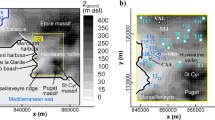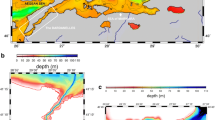Abstract
We complete the analysis of the data obtained during the experimental campaign around the semi circular bay of Quiberon, France, during two weeks in June 2006 (see Part 1). A reanalysis of numerical simulations performed with the Advanced Regional Prediction System model is presented. Three nested computational domains with increasing horizontal resolution down to 100 m, and a vertical resolution of 10 m at the lowest level, are used to reproduce the local-scale variations of the breeze close to the water surface of the bay. The Weather Research and Forecasting mesoscale model is used to assimilate the meteorological data. Comparisons of the simulations with the experimental data obtained at three sites reveal a good agreement of the flow over the bay and around the Quiberon peninsula during the daytime periods of sea-breeze development and weakening. In conditions of offshore synoptic flow, the simulations demonstrate that the semi-circular shape of the bay induces a corresponding circular shape in the offshore zones of stagnant flow preceding the sea-breeze onset, which move further offshore thereafter. The higher-resolution simulations are successful in reproducing the small-scale impacts of the peninsula and local coasts (breeze deviations, wakes, flow divergences), and in demonstrating the complexity of the breeze fields close to the surface over the bay. Our reanalysis also provides guidance for numerical simulation strategies for analyzing the structure and evolution of the near-surface breeze over a semi-circular bay, and for forecasting important flow details for use in upcoming sailing competitions.












Similar content being viewed by others
References
Adams E (1997) Four ways to win the sea breeze game. Sailing World (March):44–49
Antonelli M, Rotunno R (2007) Large-eddy simulation of the onset of the sea breeze. J Atmos Sci 64:4445–4457. https://doi.org/10.1175/2007JAS2261.1
Barré S, Calmet I, Herlédant O, Hiachkine P, Kobus JM, Mestayer PG, De Nomazy C, Piquet T, Quillard O, Rosant JM (2007) The Quiberon 2006 experiment: description and first results on the sea-breeze local behavior. In: Preprints, 7th conference on coastal atmospheric and oceanic prediction and processes, San Diego, 10–13 Sept. 2007, Am Meteorol Soc, P 15.1, p 5
Basu S, Porté-Agel F (2006) Large-eddy simulation of stably stratified atmospheric boundary layer turbulence: a scale dependent dynamic modeling approach. J Atmos Sci 63:2074–2091
Basu S, Foufoula-Georgiou E, Vinuesa J-F, Pahlow M (2006) Revisiting the local scaling hypothesis in stably stratified atmospheric boundary-layer turbulence: an integration of field and laboratory measurements with large-eddy simulations. Boundary-Layer Meteorol 119:473–500
Basu S, Vinueza J-F, Swift A (2008) Dynamic LES modeling of a diurnal cycle. J Appl Meteorol Climatol 47:1156–1174
Bernot JY (2007) Météo locale : croisière et régate (in French), Gallimard/FFV (Fédération française de voile). Paris, France (ISBN : 978-2-7424-1944-9)
Bocher E, Petit G (2012) OrbisGIS: geographical information system designed by and for research. In: Bucher B and Le Ber F (eds). Innovative software development in GIS, ISTE and Wiley. Geographical Information System series, Uppal pp 25–66
Calmet I, Mestayer PG (2016) Study of the thermal internal boundary layer during sea-breeze events in the complex coastal area of Marseille. Theor Appl Climatol 123:801–826. https://doi.org/10.1007/s00704-015-1394-1
Calmet I, Leroyer S, Mestayer PG (2007) High-resolution simulations of the urban atmosphere in sea-breeze conditions. In: Preprints 7th symposium urban environment. San Diego, 10–13 (Sept. 2007) Am Meteorol Soc Com J6.3
Carlson TN, Boland FE (1978) Analysis of urban-rural canopy using a surface heat flux/temperature model. J Appl Meteorol 17:998–1013
CEC (1993) CORINE land cover technical guide. Technical Report EUR 1285 EN, Office for the Official Publications of the European Communities, Luxembourg
Chen F, Dudhia J (2001) Coupling an advanced land surface-hydrology model with the Penn State-NCAR MM5 modeling system. Part 1: model implementation and sensitivity. Mon Weather Rev 129:569–585
Chow FK, Weigel AP, Street RL, Rotach MW, Xue M (2006) High-Resolution Large-Eddy simulations of flow in a steep alpine valley. Part I: methodology, verification, and sensitivity experiments. J Appl Meteorol Climatol 45:64–86
Crosman ET, Horel JD (2010) Sea and lake breezes: a review of numerical studies. Boundary-Layer Meteorol 137:1–29
Deardorff JW (1980) Stratocumulus-capped mixed layers derived from a three-dimensional model. Boundary-Layer Meteorol 18:495–527
Dudhia J (1989) Numerical study of convection observed during the winter monsoon experiment using a mesoscale two-dimensional model. J Atmos Sci 46:3077–3107. https://doi.org/10.1175/1520-0469
Ek M, Mahrt L (1991) OSU 1-D PBL Model User’s Guide. Department of Atmospheric Sciences, Oregon State University, Corvallis
Herlédant O (2011) Étude numérique et expérimentale de la micro-météorologie des sites de régates côtières appliquée à la baie de Quiberon. Doctoral Thesis (in French), Ecole Centrale de Nantes, pp 218. https://tel.archives-ouvertes.fr/LHEEA/tel-00980030v1
Hong SY, Noh Y, Dudhia J (2006) A new vertical diffusion package with an explicit treatment of entrainment processes. Mon Wea Rev 134:2318–2341. https://doi.org/10.1175/MWR3199.1
Houghton D, Campbell F (2005) Wind strategy, 3rd edn. Wiley, London, p 128
Hu XM, Klein PM, Xue M (2013) Evaluation of the updated YSU planetary boundary layer scheme within WRF for wind resource and air quality assessments. J Geophys Res Atmos 118:10490–10505. https://doi.org/10.1002/jgrd.50823
Kain JS, Fritsch JM (1993) Convective parameterization for mesoscale models: the Kain-Fritsch Scheme. In: The representation of cumulus convection in numerical models. Meteorological Monographs, vol 24. American Meteorological Society, Boston, pp 165–170
Leroyer S, Calmet I, Mestayer P (2010) Urban boundary layer simulations of sea-breeze over Marseille during the ESCOMPTE experiment. Int J Environ Pollut 40:109–122. https://doi.org/10.1504/IJEP.2010.030887
Mestayer PG, Calmet I, Herlédant O, Barré S, Piquet T, Rosant JM (2018) A coastal bay summer breeze study, part 1: results of the Quiberon 2006 experimental campaign. Boundary-Layer Meteorol (this issue) https://doi.org/10.1007/s10546-017-0-314-6
Michioka T, Chow FK (2008) High-resolution large-eddy simulations of scalar transport in atmospheric boundary layer flow over complex terrain. J Appl Meteorol Climatol 47:3150–3169. https://doi.org/10.1175/2008JAMC1941.1
Miller STK, Keim BD, Talbot RW, Mao H (2003) Sea-breeze: structure, forecasting and impacts. Rev Geophys 41:1-1–1-31. https://doi.org/10.1029/2003RG000124
Mlawer EJ, Taubman SJ, Brown PD, Iacono MJ, Clough SA (1997) Radiative transfer for inhomogeneous atmospheres: RRTM, a validated correlated-k model for the longwave. J Geophys Res Atmos 102:16663–16682. https://doi.org/10.1029/97JD00237
Skamarock WC, Klemp J, Dudhia J, Gill D, Barker D, Duda M, Huang X, Wang W, Powers J (2008) A description of the advanced research WRF version 3. NCAR Tech Note NCAR/TN-475+STR, pp 113
Smith SD (1988) Coefficients for sea surface wind stress, heat flux, and wind profiles as a function of wind speed and temperature. J Geophys Res 93:15467–15472
Steele CJ, Dorling SR, von Glasow R, Bacon J (2013) Idealized WRF model sensitivity simulations of sea breeze types and their effects on offshore windfields. Atmos Chem Phys 13:443–461
Sun WY, Chang CZ (1986) Diffusion model for a convective layer. Part I: Numerical simulation of convective boundary layer. J Appl Meteorol Climatol 25:1445–1453. https://doi.org/10.1175/1520-0450
Xue M, Droegemeier KK, Wong V (2000) The advanced regional prediction system (ARPS)—s multi-scale nonhydrostatic atmospheric simulation and prediction tool. Part I: model dynamics and verification. Meteorol Atmos Phys 5:161–193. https://doi.org/10.1007/s007030070003
Xue M, Droegemeier KK, Wong V, Shapiro A, Brewster K, Carr F, Weber D, Liu X, Wang D (2001) The Advanced regional prediction system (ARPS)—a multi-scale nonhydrostatic atmospheric simulation and prediction tool. Part II: model physics and applications. Meteorol Atmos Phys 76:143–166. https://doi.org/10.1007/s007030170027
Acknowledgements
The authors acknowledge the funding of O. Herlédant’s doctoral work by the Centre National de la Recherche Scientifique (CNRS) and the Région des Pays de la Loire. This work was granted access to the HPC resources of CINES (Centre Informatique National de l’Enseignement Supérieur) under the allocation 2009015103 made by Grand Equipement National de Calcul Intensif (GENCI). We also acknowledge the numerous positive recommendations of an unknown reviewer. The background of Fig. 1b is a map from Géoportail. Trade names and companies are given for the benefit of the reader and do not imply any endorsement of the product or company by the authors.
Author information
Authors and Affiliations
Corresponding author
Rights and permissions
About this article
Cite this article
Calmet, I., Mestayer, P.G., van Eijk, A.M.J. et al. A Coastal Bay Summer Breeze Study, Part 2: High-resolution Numerical Simulation of Sea-breeze Local Influences. Boundary-Layer Meteorol 167, 27–51 (2018). https://doi.org/10.1007/s10546-017-0319-1
Received:
Accepted:
Published:
Issue Date:
DOI: https://doi.org/10.1007/s10546-017-0319-1




